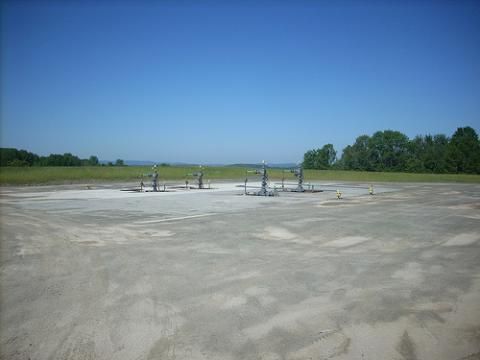
Natural gas well in Pennsylvania, July 2011. Photo by Jerry Dincher, via Flickr.
The New York Times' Ian Urbina, who has been spearheading the Grey Lady's coverage of hydraulic fracturing, has uncovered what seems to be the first documented case of drinking water contaminaiton by the process of hydraulic fracturing.
Urbina's story, which was published today, is based on a 1987 report to Congress by the federal Environmental Protection Agency about a water well in West Virginia that was contaminated by hydraulic fracturing fluids in 1984. The Times has helpfully uploaded the original report online, so you can read it for yourself here.
Here's Urbina's summary of the EPA's findings:
The report concluded that hydraulic fracturing fluids or gel used by the Kaiser Exploration and Mining Company contaminated a well roughly 600 feet away on the property of James Parsons in Jackson County, W.Va., referring to it as “Mr. Parson’s water well.”
“When fracturing the Kaiser gas well on Mr. James Parson’s property, fractures were created allowing migration of fracture fluid from the gas well to Mr. Parson’s water well,” according to the agency’s summary of the case. “This fracture fluid, along with natural gas was present in Mr. Parson’s water, rendering it unusable.”
This decades-old report is making the news now because the drilling industry has claimed that there has never been a documented case of drinking water contamination by hydraulic fracturing. Now there might be at least one.
And there might be more documented cases of contaminated drinking water, the story points out, but because legal settlements with the affected landowners seal the details of many suspected contamination cases, government regulators will never know about them.
The story also suggests that abandoned wells near the contaminated West Virginia well might have played a role in its contamination. New York State has aout 70,000 abandoned oil and gas wells, and only knows the location of 30,000 of them, according to the New York State Department of Environmental Conservation's website:
At least 70,000 oil and gas wells have been drilled in New York since the 1800's, but information is available for only about 30,000 of them. Locations for the others are unknown, and wells have been found in such unexpected places as basements, stream banks and under parking lots. Abandoned wells may pose hazards not only to walking on the ground surface if outdoors, but also to ground water resources if not properly plugged. In addition, they provide a potential conduit for leakage of oil, gas or brine to the atmosphere, soil or surface water.











